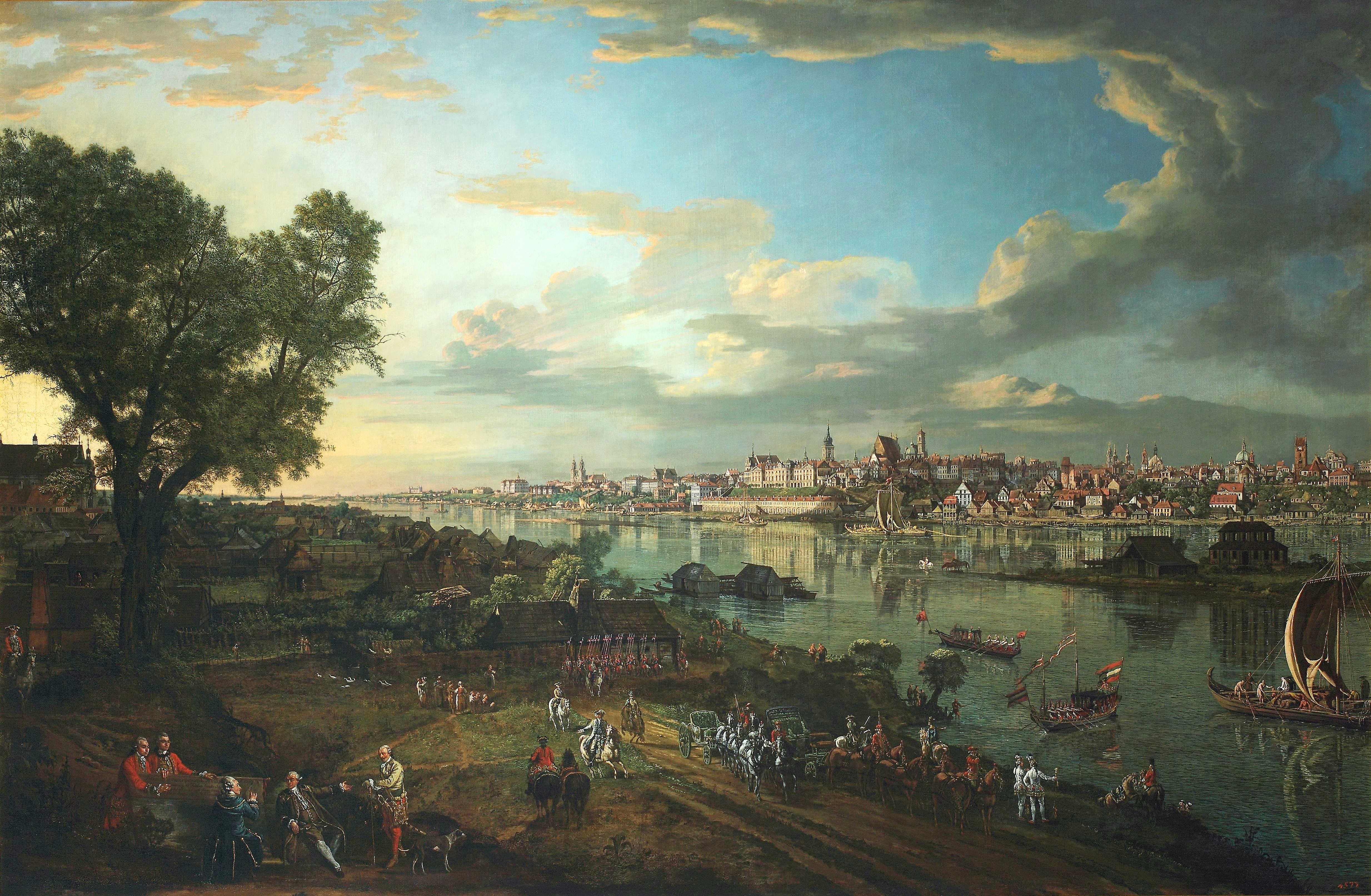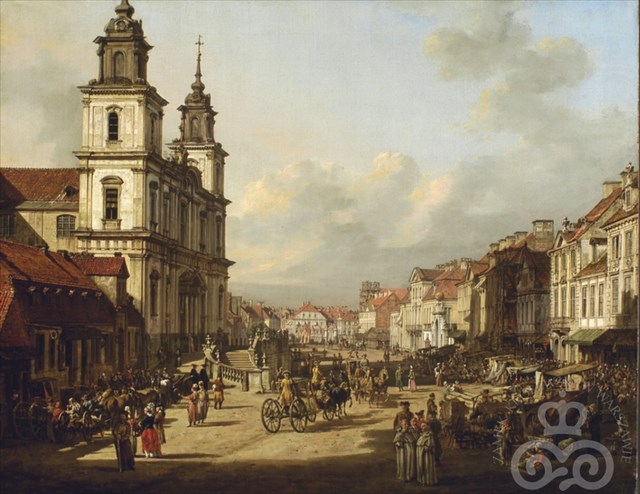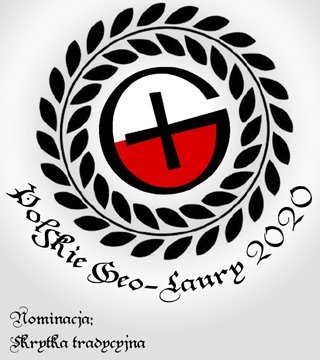
for English version please scroll down
W 1767 roku do Warszawy przybył wybitny włoski malarz Bernardo Bellotto. Zatrzymał się tutaj podczas swojej podróży z Drezna do Petersburga. Liczył, że dostanie od Stanisława Augusta Poniatowskiego wstawiennictwo, z którym mógłby się później udać na dwór carycy Katarzyny II. Jednak przyszłość miała dla niego inne plany - mistrz został tu do końca życia, a najwybitniejsze z jego dzieł przestawiają właśnie widoki stolicy.

Autoportret w stroju ambasadora weneckiego
Artysta urodził się w 1721 roku w Wenecji, gdzie spędził dzieciństwo i młodość. Pochodził z rodziny mieszczańskiej, w której zawód malarza był dziedziczony. Praktykował u swojego wuja – Antonio Canal (także zwanego Canalettem) – malując początkowo widoki Wenecji.
W wieku dwudziestu siedmiu lat razem z żoną i synkiem opuścił ojczyznę i wyruszył szukać szczęścia, pieniędzy i sławy na dworach Europy. W latach 1747-58 przebywał na dworze króla Augusta III w Dreźnie. Zdobył tu uznanie – już po roku piastował urząd i tytuł „malarza królewskiego”, otrzymywał wysoką pensję. W czasie swojego pobytu na drezdeńskim dworze Bellotto malował głównie panoramy i zabytki Drezna. W latach 1758-61 pracował na dworach: cesarskim w Wiedniu i elektorskim w Monachium. W 1762 roku przybył znów do Drezna spustoszonego w czasie wojny siedmioletniej. Pozostał w tym mieście do początku 1767 roku, sprawując w drezdeńskiej Akademii Sztuk Pięknych podrzędne i niskopłatne stanowisko profesora perspektywy. By podreperować swoje finanse, wybrał się do Petersburga, ale nigdy tam nie dotarł. Po drodze zatrzymał się w Warszawie i wkrótce został nadwornym malarzem Stanisława Augusta.

Incepcja - Fragment obrazu "Widok Warszawy od strony Pragi" (lewy dolny róg).
Canaletto maluje tutaj ten właśnie obraz

"Widok Warszawy od strony Pragi"
W Warszawie Bernardo Bellotto mieszkał przez trzynaście lat - aż do swojej śmierci. W tym czasie namalował około siedemdziesięciu obrazów – cykl widoków Warszawy i okolic, obrazy historyczne, sceny rodzajowe, fantazje architektoniczne, widoki Rzymu, a także dekoracje teatralne. Dla nas, Polaków, najważniejszy jest właśnie ten polski okres twórczości Bernardo Bellotto. Powstał wówczas cykl wedut warszawskich, czyli pejzaży przedstawiających ujęcie całości miasta lub jego fragmentów. Obrazy te przekazują nam bogatą wiedzę o stolicy w XVIII w. Mają one – oprócz wielkich walorów artystycznych – wartość dokumentów. Warszawskie weduty Canaletta są prawdziwą kopalnią informacji dla historyków architektury, urbanistyki, kostiumologów czy historyków obyczajów. Współczesna Warszawa – a przynajmniej niektóre jej zabytkowe pałace, kamienice i kościoły, odbudowane z wojennych zgliszcz – zawdzięcza swój wygląd i kształt między innymi rycinom i obrazom Bellotta, który precyzyjnie i z detalami uchwycił stolicę: jej architekturę i życie. Twórczość Bellotta wpłynęła na polskie malarstwo historyczne i krajobrazowe, m.in. twórczość Zygmunta Vogla, Marcina Zaleskiego i innych malarzy wedutystów. Tradycja Bellotta w dziedzinie widoku miejskiego była jednym z nurtów polskiego realizmu pierwszej połowy XIX wieku.


Krakowskie Przedmieście od kolumny Zygmunta. Obraz namalowany w latach 1767-1768.


Kościół Świętego Krzyża. Obraz namalowany w 1778 r.


Kościół Sakramentek. Obraz namalowany w 1778 r.


Pałac Rzeczypospolitej (Krasińskich). Obraz namalowany w 1778 r.


Kościół Karmelitów. Obraz namalowany w 1780 r.


Kościół Wizytek. Obraz namalowany w 1780 r.
Małpie figle Canaletta:
Niestety, nie udało mi się zdobyć niezbitych dowodów na prawdziwość tej historii. Nawet, jeśli jest to tylko miejska legenda, to z całą pewnością zasługuje na własną skrzynkę. Przedstawiam Wam zatem tamte wydarzenia tak, jak je sobie wyobrażam. Jest rok 1777. Nasz bohater dostał za zadanie namalowanie kolejnego obrazu przedstawiajacego ulicę Miodową. Canaletto mieszka w Warszawie już 10 lat. Z całą pewnością zżył się z tym miastem, a ono zżyło się z nim. Normalną rzeczą jest, że wśród licznych przyjaciół miał też grono osób, za którymi z jakiegoś powodu nie przepadał...
Bernardo siedzi na zydelku i maluje Warszawę. Miasto żyje, gdzieniegdzie bawią się dzieci, tu i tam w błocie leży jakiś żebrak, a co chwila po bruku przejeżdża bogata kareta.
Canaletto nabiera kolejną porcję farby i już ma nakładać pierwszy kolor na obrazie z pałacem Branickich, ale w ostatniej chwili zaciska zęby i zatrzymuje pędzel nad płótnem.
Tutaj zdradzę Wam, że Braniccy należeli do grupy, której nie darzył sympatią. Nie wiemy, co było powodem wrogich stosunków między nimi (a jeśli nie wiadomo o co chodzi, to chodzi o...). Wiemy jednak, że nie był to pierwszy artysta, z którym mieli na pieńku, np. projektant ich pałacu, Jan Zygmunt Deybel, został odsunięty od wykonywanego projektu w połowie jego budowy.

Ulica Miodowa. Obraz namalowany w 1777 r.
Pałac Branickich po prawej
Naburmuszony malarz ma właśnie przystąpić do malowania pałacu, gdy nagle dociera do niego, jakie ma przed sobą możliwości. To przecież on kreuje rzeczywistość na swoim obrazie. To on może dokonać na nim zmian, by wyrazić swoją dezaprobatę wobec tych ludzi. Kilka ruchów pędzlem i może upokorzyć ich przed całą Warszawą. Nie powinno to być nic widocznego, obraz przecież trzeba sprzedać królowi, ale... Już wie, co namaluje. To będzie coś, czego będą się wstydzić, coś, czego żaden szanujący się arystokrata nie chciałby mieć na fasadzie swojej posiadłosci, coś, co będzie na zawsze plamić ich imię... Nabiera farbę i w jednym miejscu przelewa na płótno całą swoją gorycz.

Pałac Branickich dziś
Obraz został powieszony w Zamku Królewskim. Wśród namalowanych na płótnie rzeźb zdobiących fasadę pałacu Branickich było coś, co w rzeczywistości się tam nigdy nie znajdowało.
Gdyby ujrzała to jakaś dama, na pewno by się zaczerwieniła i odwróciła wzrok, gdyby dowiedział się o tym Branicki, na pewno kazałby zniszczyć obraz. Bernardo Bellotto, szanowany i ceniony artysta, nadworny malarz Stanisława Augusta Poniatowskiego, umieścił na pałacu Branickich... małpę z kiścią bananów.
Czego się spodziewaliście? To był XVIII wiek, wtedy z całą pewnością był to wyraz całkowitego znieważenia. Doceńcie wysublimowany poziom tej okrutnej zemsty.

DEAL WITH IT
Okazuje się, że to nie koniec tej historii. Malarz za pomocą pędzla zmienił rzeczywistość ukazaną na obrazie, ale nie mógł przewidzieć, co się stanie w przyszłości - albowiem wielki finał tej opowieści dokonał się całkiem niedawno...
Po namalowaniu obraz wraz z innymi trafił do Zamku Królewskiego, gdzie zdobił (i zdobi po dziś dzień) tamtejszą kolekcję. Jak wiemy, nasz kraj przechodził przez różne okresy, wśród których były i te szczęśliwe, i te tragiczne. W 1939 roku hitlerowcy zrzucili na królewską rezydencję bomby. Wszystkie dzieła naszego artysty szczęśliwie ocalono. W 1944 roku Warszawa, w tym Stare Miasto, została zmieciona z powierzchni ziemi. Po pięknych uliczkach, którymi spacerował Canaletto, nie został nawet ślad. Po zabytkach, które malował, zostały tylko ruiny - tak też skończył pałac Branickich.
Bernardo Bellotto żył 150 lat przed tymi wydarzeniami, ale wymalował nam Warszawę taką, którą chcieliśmy przywrócić. Jego obrazy pomogły odbudować to, co zostało zburzone. Wśród jego dzieł jest jeden obraz - Ulica Miodowa - a na nim pałac, który został odbudowany na dawnym miejscu, a jego ostatni budowniczowie dokonali wszelkich starań, by wyglądał dokładnie tak jak na obrazie... To właśnie dzięki naszemu artyście, gdy idziemy dziś ulicą Miodową i przyglądamy się kolorowej fasadzie pałacu Branickich, możemy ujrzeć go takim, jaki był w 1777 roku (choć dziś nie świeci on już dawnym blaskiem). Mimo że minęło 250 lat, wciąż możemy cieszyć się widokiem zdobień na jego fasadzie i rzeźb, w tym... małpy z kiścią bananów - jestem pewien, że niejedna dama odwraca przy niej wzrok.
 Special thanks to haniagaj for the English description
Special thanks to haniagaj for the English description
polska wersja znajduje się powyżej
In 1767, the outstanding Italian painter, Bernardo Bellotto (who often called himself Canaletto) arrived in Warsaw. He made a stop here during his journey from Dresden to Saint Petersburg, hoping to obtain from King Stanisław August Poniatowski a letter of introduction, which he could then present at the court of Empress Catherine the Great. Fate, however, had different plans for him – the master stayed in Warsaw for the rest of his life, and his finest works present views of Warsaw.

Self-portrait as a Venetian ambassador
Bellotto was born in Venice in 1721, and it was there that he spent his childhood and youth. He hailed from a bourgeois family, where the occupation of painter was passed on from father to son. He studied in the workshop of his uncle, Antonio Canal (who was also known as Canaletto), and his early works were views of Venice.
At the age of twenty seven, accompanied by his wife and young son, Bellotto left his homeland in search of fame and fortune at the courts of Europe. He spent 1747 to 1758 at the court of King August III of Poland in Dresden. His reputation grew rapidly – just one year after his arrival, he was officially awarded the title of Royal Painter together with a high salary. During that time, he painted mainly cityscapes presenting panoramas and monuments of Dresden. From 1758 to 1761, he worked at the Imperial Court in Vienna and at the Elector's Court in Munich. In 1762 he returned to Dresden, which by then had been ravaged in the course of the Seven Years' War. He stayed there until the beginning of 1767, teaching perspective at the Dresden Academy of Fine Arts – a low-level and poorly paid position. He then set out for Saint Petersburg in order to make some money – but he never got there. On his way he stopped in Warsaw, and soon thereafter he became the court painter of Stanisław August Poniatowski.

Inception – fragment of the painting View of Warsaw from the Praga side (lower left corner).
Canaletto is shown here working on this very painting.

"View of Warsaw from the Praga side"
Bernardo Bellotto lived in Warsaw for thirteen years, up until his death. In this period he painted some seventy paintings – a series of landscapes of Warsaw and its environs, historical paintings, genre scenes, architectural fantasies, views of Rome, as well as some theatrical scenery. For us, Poles, it is this Polish period of Bellotto's creativity that is the most important , for this is when his series of Warsaw vedute (landscapes showing panoramas or fragments of the city) was created. These paintings convey a wealth of knowledge about the eighteenth century capital. Besides posessing great artistic value, they serve as priceless historical documents. Canaletto's Warsaw vedute are a veritable gold mine of information for historians of architecture, urban studies, costumes, and customs. Contemporary Warsaw – or at least some of its historical palaces, tenements, and churches, reconstructed from the ruins of World War II – owes its shape and appearance to, among others, the prints and paintings of Bellotto, who captured with great precision and attention to detail the life and architecture of the capital. His artistry influenced Polish historical and landscape painting, and this influence can be seen in the works of Zygmunt Vogel, Marcin Zaleski, and other vedutisti. The Bellotto cityscape tradition became one of the trends in Polish realist painting of the first half of the nineteenth century.


"Krakowskie Przedmieście from Kolumna Zygmunta". Painted in 1767-1768.


"Church of the Holy Cross". Painted in 1778.


"St. Casimir's Church". Painted in 1778.


"Palace of the Commonwealth (Krasiński Palace)". Painted in 1778.


"Carmelite Church". Painted in 1780.


"Visitationist Church". Painted in 1780.
Canaletto's monkey bussiness:
Unfortunately, I have been unable to gather irrefutable evidence as to the accuracy of the following story. But even if it is just an urban legend, it certainly deserves a cache. Therefore, I present here a version of the events as I imagine them.
It is 1777. Our protagonist is given the task of painting yet another image – this time, it's Miodowa Street. Canaletto has lived in Warsaw for 10 years by now. He has certainly grown accustomed to the city, and the city – to him. As is usually the case, among his large group of friends there were some whom he did not care for, for one reason or another... Bernardo is sitting on a stool and painting Warsaw. The city is pulsing with life: children are playing everywhere, here and there a beggar lies in the mud, fancy carriages pass along the paved roads.
Canaletto dips his brush in paint and is about to add color to the beautiful Branicki Palace when he clenches his teeth and, at the last minute, suspends his brush mid-air over the canvas.
I will now reveal to you that the Branickis were among the people Canaletto did not care for. We do not know what caused the hostility between them, though according to a Polish saying, if you don't know what something's about, it's probably about money... We do know that he was not the only artist with whom they did not get along – even the architect of their palace, Jan Zygmunt Deybel, was removed from the project in the middle of its construction.

Miodowa Street. Painted in 1777.
The Branincki Palace on the right
The sulking painter was about to paint the Branicki Palace, when he suddenly realized the opportunities before him. It is he, after all, that creates the reality presented by his painting. It is he who can make some changes to express his disapproval of these people – with a few brush strokes he can humiliate them in front of all of Warsaw. It can't be anything too obvious – after all, he must be able to sell the painting to the king – but... Suddenly, he knows just what to paint. It will be something they will be ashamed of, something that no self-respecting aristocrat would want on the facade of his palace, something that will forever mar their good name. He dips his brush in paint and transfers all his accumulated bitterness onto one tiny space on the canvas.

The Branicki Palace today
In the finished canvas that was to hang at the Royal Castle, among the many sculptures painted on the facade of the Branicki residence, there was one that in reality was never there. If a lady noticed it, she would surely blush and look away; if Branicki found out about it, he would surely order the painting destroyed. Bernardo Bellotto, the respected and valued artist, the court painter of King Stanisław August Poniatowski, decorated the Branicki Palace with... a statue of a monkey with a bunch of bananas.
Well, what did you expect? This was the eighteenth century, and certainly at that time it was a major insult. Do appreciate the sophistication of this cruel revenge.

DEAL WITH IT
It turns out, however, that this is not the end of the story. The artist, with his brush, changed the reality depicted in the painting, but he couldn't have predicted what would happen in the future – for the grand finale of this story occurred quite recently... In 1944, Warsaw, together with its Old Town, was wiped off the face of the earth by the Nazis. Nothing remained of the beautiful streets strolled by Canaletto. The buildings and monuments he painted were all in ruins – including the Branicki Palace.
Even though he lived and worked 150 years prior to any of this, Bernardo Bellotto painted for us the Warsaw that we wanted to reconstruct. His paintingshelped to rebuild that which had been destroyed. Among these paintings was one of Miodowa Street, and in it, a palace. This palace was reconstructed to occupy its old space, and its last builders did all they could to make it look exactly as it did in the painting... So it is thanks to Bellotto that, walking down Miodowa Street today and admiring the colorful facade of the Branicki Palace, we can see it exactly as it appeared in 1777 (though today it lacks its original sheen). Although 250 years have passed, we can still delight in its ornate facade, its sculptures and... the monkey with a bunch of bananas. I am sure many a lady looks away.
Skrytka nominowana w konkursie Polskie Geo-Laury 2020